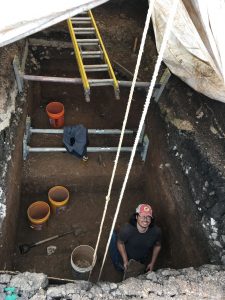Archaeology Update for the Week of January 30
The POLAR-LAR-LAR VORTEX-EX-EX-EX is sweeping through the midwest this week and there are some REALLY cold temperatures out there in some parts of the country. Everyone out there in the thick of it, we hope that you are staying safe and warm. We appear to have dodged Jack Frost here in central Texas. It’s still cold by Texas standards, though. The shelters have been holding up fairly well and we’ve had a long(-ish) break from the heaviest rains, so YAY!
Block D has all the support it needs
We mentioned it in last week’s update: shoring was on its way to Block D. Well, it’s here now! These large braces push hard against the block walls and make sure that they don’t cave in on the archaeologists who are working below. Remember, soil is HEAVY; a cubic yard weighs a ton (literally). As we dig deeper and deeper into these test units, the weight of the soil pushing downward and outward increases and shoring like this assures that everyone stays safe. The crews are likely going to be getting back to work in Block D later this week (maybe even today!).

UT San Antonio’s own archaeologist groundhog, Jason Perez is back in Block D with the shoring in place, having to look wa-a-a-ay up!
That’s one fancy shelter you have there for Block C, Mindy…
For the past few weeks, Mindy has been working hard, figuring out a solution to this constant inundation problem in Block C. This week she finished up installing a new frame and cover to protect this really promising block that we’ve continued to be pushed out of by rains (and busted water mains!). With this cover in place, the sky’s the limit on what we’ll be able to get through in Block C (even though we’re going downward away from the sky, and the tarps on the cover actually keep us from seeing the sky, but you get the idea…).

Let’s hope this will be the solution to all of Block C’s problems.
Block A keeps being our excavation workhorse!
Over in Block A, the crews have been plugging along, removing those various layers of features and reaching an overall maximum depth of 1.3 meters below the ground surface. Crews have exposed and recorded 19 prehistoric features so far in this excavation with a significant number of them coming from Good Ol’ Block A. All those features do wind up taking longer to work through than just normal soil. It’s slow going, but it’s still going…
You can watch a full five hours of hard work in the span of one relaxing minute from our latest excavation time-lapse here. Look at those busy little bees…
What do we have in store for the week ahead?
Tomorrow morning at 10 AM (I’m sure you’ve set your watches, phones, and calendars at this point), we have our latest installment of the YouTube Live Excavation Update. This week, we’ll be talking a bit about landforms and why we’re digging here and not on top of that tall bluff on the other side of the Comal Springs – besides that the residents of the retirement community up there might get annoyed by the dust in their living rooms. It all has to do with flooding and soil deposition over the centuries. Tune in and check it out!
Special guests are coming to visit, too…
We are looking forward to a pretty important visit this time next week when several members of the Texas Historical Commission’s Archaeology Division come out for a tour. We have been working closely with the Commission for a long time on this project, because they are a key component of the regulations that are driving the excavations to begin with. The Commission (we tend to call them THC for short), is the State Historic Preservation Office (SHPO; pronounced like “ship” with an “O” at the end) for the State of Texas (every state has one). Under a section of a federal law called the National Historic Preservation Act of 1966, federal agencies have to know what their actions might do to important cultural resources like archaeological sites. Though they do their best to know what’s important, these agencies need to talk to others to find out what is really important. In a roundabout way, it’s kind of like asking your mom what your dad wants for his birthday. You have an idea what he’d like, but it’s best to talk to someone who knows him best to make sure you get something good. The federal agencies talk to SHPOs because they represent the preservation management interests of the states. The THC does this for Texas. Every federally-recognized Tribe has a similar representative called a Tribal Historic Preservation Officer (THPO) who does the same for Tribal interests.

The THC’s fun logo, which some affectionately call the “Tex-clamation point!” Get it!?! I think it’s clever.
While most of the staff archaeologists aren’t working on this project, they like to stay apprised of the work going on across the state. It’s a big deal to have them all come out to visit, so we are proud and nervous (well, mostly proud…) But big bummer… I asked and was told that the THC does not have a bus that they can all pile into to make these big site visits. That would be cool if they did, though… I bet it would have to be a vintage model like one of these.

Well, I think that about covers it for this week! Check back here again next week!


